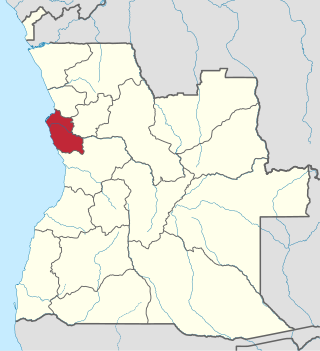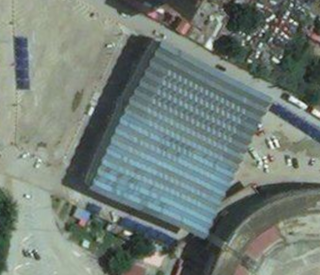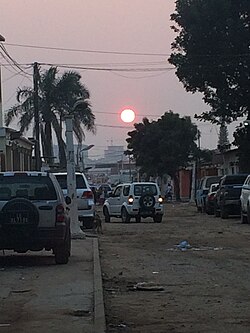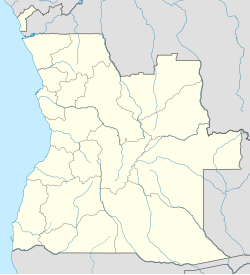
Luanda is the capital and largest city of Angola. It is Angola's primary port, and its major industrial, cultural and urban centre. Located on Angola's northern Atlantic coast, Luanda is Angola's administrative centre, its chief seaport, and also the capital of the Luanda Province. Luanda and its metropolitan area is the most populous Portuguese-speaking capital city in the world and the most populous Lusophone city outside Brazil, with over 8.3 million inhabitants in 2020.

Zaire is one of the 18 provinces of Angola. It occupies 40,130 square kilometres (15,490 sq mi) in the north west of the country and had a population of 594,428 inhabitants in 2014. It is bordered on the west by the Atlantic Ocean, on the north by the Democratic Republic of Congo, on the east by the Uíge Province, and on the south by the Bengo Province.

Luanda is a province of Angola. It covers an area of 18,835 km2, and had a population of 6,945,386 at the Census of 16 May 2014. The latest official estimate is 9,079,811.

Saurimo, formerly known as Henrique de Carvalho, is a city in Angola. It is the capital of Lunda Sul Province. As of 2014, Saurimo has a population of 393,000 people, which steadily grows as a result of migration.

Pavilhão da Cidadela is an Angolan indoor sporting arena located in Luanda, Angola. The capacity of the arena is 6,873 people. It is used to host the Atlético Petróleos Luanda and formerly of the Angola national basketball team before the appearance of Pavilhão Multiusos do Kilamba.
Cazenga is a city and the most densely populated of the nine municipalities that make up the province of Luanda, Angola. It has a population of 892,401, with an estimated 1,045,722 in 2019, covering an area of 37 km2.

Samba is one of the six urban districts that make up the municipality of Luanda in Luanda Province, Angola.
Jamba is a town and a municipality, with a population of 105,090, in the province of Huíla, Angola.

The Communes of Angola are administrative units in Angola after municipalities. The 163 municipalities of Angola are divided into communes. There are a total of 618 communes of Angola:

Ícolo e Bengo is a city council in the province of Luanda in Angola. It had a population of 81,144 in 2014.
Cacuso is a town and municipality in Malanje Province in Angola.
Ingombota is one of the six urban districts that make up the municipality of Luanda, in the province of Luanda, the capital city of Angola. Ingombota is home to the central business district of Luanda, Angola. The economic, political and symbolic center of the city and the nation, it is Luanda's oldest district. The district is home to most of Luanda's prominent hotels and office towers.

Rangel is one of the six urban districts that make up the municipality of Luanda, in the province of Luanda, the capital of Angola. The Rangel District is one of the older and more urbanized in Metropolitan Luanda. The district has an area of 6.2 square kilometers. The district is best known as the home of Americo Boavida University Hospital as well as several large sporting facilities including Pavilhão da Cidadela, Pavilhão Anexo and Pavilhão Anexo II.
Quilamba is an Angolan neighborhood that serves as the administrative center of Belas Municipality and a large housing development site 30 km from Luanda, the capital city of Angola. It is being built by the China International Trust and Investment Corporation.
The Municipality of Luanda is one of the nine municipalities that make up the province of Luanda, Angola. It covers roughly 116 km2 and includes Ilha de Luanda. The population was 2,194,747 at the 2014 census and is projected to be 2,571,861 in 2019 per Instituto Nacional de Estatística, República de Angola.

Maianga is one of the six municipalities of the administrative division of the province of Luanda, Angola. In 2011, as part of a restructuring of Luanda's regional government, the municipality was designated as one of Luanda's six urban districts. The area is one of the older quarters of Luanda and was established before independence. The area is best known for Quatro de Fevereiro Airport and its strong musical culture.
The following is a timeline of the history of the city of Luanda, Angola.
Polivalentes Futebol Clube is an Angolan football club based in the Palanca neighborhood in Kilamba Kiaxi, Luanda. They currently play in Gira Angola the Angolan Second Division.

Talatona is a city and municipality in the province of Luanda, bordering the Angolan capital, Luanda.
The Luanda Light Rail is a proposed light rail line to be built in the Angolan capital city Luanda, at a projected cost of US $3 billion.












